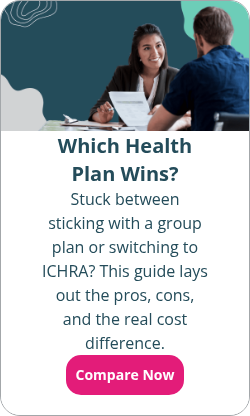What is a no-deductible health plan?
By Elizabeth Walker on October 2, 2023 at 9:05 AM
Employers have several types of health plans to choose from when designing their benefits packages. Because attracting and retaining talented workers is a high priority for many organizations, employers often look for the best health plan available.
One option that appeals to many employers is the no-deductible health plan. These plans are attractive because they cover healthcare costs immediately, eliminating high out-of-pocket expenses for employees. But, no-deducible health plans have high premiums, which may make them difficult for some employers to afford.
In this article, we’ll go over everything you need to know about no-deductible health insurance plans. We’ll also walk you through alternative health plan options and explain how you can supplement your existing group plan to offer your employees even greater coverage.
What is a no-deductible health plan?
A no-deductible health plan, also called a zero-deductible policy, is a health insurance plan that doesn’t require participants to meet a minimum out-of-pocket amount before their insurance company begins paying their medical expenses.
Because insurers begin cost-sharing immediately, no-deductible plans come with higher premiums than health plans with deductibles. Due to the costly premiums, only 17% of employees1 have a no-deductible health insurance policy. In contrast, 29% of employees with employer-sponsored health insurance have a high-deductible health plan2.
No-deductible health plans are available as group policies and also available for individuals on public and private health exchanges, including the federal Health Insurance Marketplace. Most no-deductible policies are platinum plans, but they can be any metal tier type, including bronze, silver, or gold.
Instead of a lower health insurance premium, a lower-tier, no-deductible plan may come with limited network providers, fewer covered health services, or higher out-of-pocket costs like copays.
How do no-deductible health plans work?
Most health plans have deductibles that policyholders must meet before their insurance company starts contributing toward their medical care. With zero-deductible plans, insurers begin sharing costs with policyholders from day one. Outside of this significant distinction, no-deductible plans work similarly to health plans with deductibles.
The items and services each no-deductible plan covers will vary based on tier type, health insurance company, and other factors. Still, every plan must cover the ten essential health benefits.
While employees won’t have to meet a deductible, they are still responsible for out-of-pocket costs like network copays, coinsurance, and payment for out-of-network providers and medical services their plan doesn’t cover.
Lastly, like other health policies, no-deductible plans have annual maximum out-of-pocket limits.
What are the pros and cons of no-deductible health plans?
Depending on your benefits budget and your workforce demographics, no-deductible health plans may be your best option. But before you make a decision, consider the pros and cons.
Below are a few advantages of no-deductible health plans:
- These plans can help your employees lower their out-of-pocket medical expenses by eliminating costly deductibles.
- These types of plans are particularly effective if you have several employees who experience high medical expenses, have a chronic illness, frequently visit their doctor, or take several medications.
- When employees know the upfront cost of their healthcare, they’re more likely to seek care promptly, whether for annual checkups, chronic health conditions, or medical emergencies. They’re also less likely to receive a surprise medical bill.
Below are a few potential disadvantages of no-deductible health plans:
- No-deductible plans have higher monthly premiums to compensate for the immediate start of cost-sharing benefits and frequent coverage use.
- Out-of-pocket costs due to cost-sharing or copayment can add up over time, especially if your employees often need healthcare.
- Depending on the type of plan, insurers may restrict eligible medical services and items, like certain prescription drugs, and limit network provider options.
What are some alternatives to no-deductible health plans?
If you like the idea of an employer-sponsored plan but can’t afford a no-deductible health plan’s high premiums, you have a few alternatives.
Low-deductible health plans (LDHPs) or high-deductible health plans (HDHP) are popular health insurance options. But, depending on your budget, and your workforce’s health and age, one may be better than the other.
To help you decide, let’s dive deeper into how the two plans work so you can understand precisely how LDHPs and HDHPs compare.
Low-deductible health plan (LDHP)
The IRS considers3 health coverage an LDHP if it has a deductible of less than $1,500 for individual coverage or $3,000 for family coverage. The major draw of an LDHP for employees is the potential to save on out-of-pocket medical costs. Employees may not have to pay much or anything after meeting their policy’s annual deductible.
Due to rising healthcare costs, budgeting and planning for healthcare expenses is critical for many workers. LDHPs make healthcare costs more predictable since employees are likelier to meet their deductible amount and afterward only pay the coinsurance and copays.
If you have a lot of employees with many dependents or have employees with a chronic or pre-existing condition, a low-deductible plan may be the most beneficial option. However, if you have a generally healthier workforce, the next option, an HDHP, could be a more cost-effective solution.
High-deductible health plan (HDHP)
HDHPs are health insurance plans with larger deductibles for medical expenses but lower monthly premiums. In 2023, an HDHP must have an individual deductible of at least $1,500 and a family deductible of at least $3,000.
While HDHPs are an affordable option in terms of premiums, employees are responsible for out-of-pocket costs until they meet their deductible—which can take longer with an HDHP.
To help offset these costs, employers can contribute additional funds toward employees' healthcare costs with a health reimbursement arrangement (HRA), health savings account (HSA)—as long as your HDHP is HSA-qualified—or a taxable health stipend.
You may find high-deductible policies appealing if you have a healthy workforce that doesn’t anticipate costly medical expenses. Employees can save money on premiums if they know they’ll only use the plan for preventive care rather than more severe medical procedures.
How can employers supplement their group health plans?
A common drawback of LDHPs and HDHPs is that, in an emergency, meeting the deductible could be a financial burden. Employees may skip doctor visits or postpone medical treatment to avoid spending money—risking their health along the way. Even if you offer a zero-deductible plan, it may not cover everything your employees may need.
Luckily, the following options are an excellent way to supplement your employer-sponsored plan so you can better control your costs and enhance your employees’ health benefits.
Integrated HRA
Your first option is an integrated HRA, also known as a group coverage HRA (GCHRA). A GCHRA is an employer-owned health benefit designed to reimburse employees enrolled in a group plan for qualified out-of-pocket costs the group policy doesn’t cover. Health insurance deductibles, copays, and coinsurance amounts are eligible expenses, but monthly premiums are ineligible for reimbursement.
If you choose an LDHP or HDHP, the deductible can be difficult for your employees to manage. In these cases, a GCHRA can help bridge the gap between the group plan and the deductible, all while lowering premium costs for you.
You can use a GCHRA with either an LDHP or an HDHP, and your GCHRA can remain in place if you change insurance providers. The GCHRA is also customizable because you can set your monthly allowance (with no minimum or maximum annual contribution limits) and choose different allowance amounts for different employee classes.
Once you determine your allowances, employees can’t exceed them, making GCHRAs a budget-friendly and flexible benefit option.
Taxable health stipends
A health stipend is another option to supplement your group health insurance plan. With a stipend, employees receive a fixed, taxable amount of money to pay for out-of-pocket medical costs, including insurance premiums. Employers typically add stipend contributions to an employee’s paycheck as wages, and employees pay income taxes on the amount they receive.
Unlike HRAs, the IRS doesn’t consider stipends as formal health benefits. So, your employees can spend their money on whatever they choose, even if it’s not medical services or items. Legally, you can’t ask your employees to prove they purchased healthcare or request that they provide you with their medical receipts.
Conclusion
Understanding health insurance costs, including deductibles and out-of-pocket expenses, is crucial to managing your company’s overall health benefit. While no-deductible health plans are a great way to support your employees’ medical needs, they may not be in your budget.
If you’re looking for affordable health insurance, you have options other than a no-deductible plan. A GCHRA can help you make an LDHP or HDHP more attractive to your employees and boost your group health insurance plan.
This article was originally published on February 16, 2022. It was last updated on October 2, 2023.
Check out more resources
See these related articles

How to tell if your HDHP is HSA-qualified
Not sure if your high deductible health plan is HSA-qualified? This article explores how to determine if you're eligible for a health savings account.

What does out-of-pocket medical expense mean?
Learn what 'out-of-pocket' medical expenses mean and how they impact your healthcare costs. Understand deductibles, copayments, and more.

How to make a high deductible health plan work for you
Are you wondering if a high deductible health plan is worth it? Find out how to maximize the benefits of an HDHP with this helpful guide!



